We're sorry, but the requests coming from your IP address appear to be automated. For this reason, we are forced to temporarily block access to search.
To continue the search, please enter the characters from the image in the input field and click “Submit”.
Cookies are disabled in your browser. Yandex will not be able to remember you and correctly identify you in the future. To enable cookies, follow the tips on our Help page.
Why did it happen so?
Perhaps the automatic requests do not belong to you, but to another user accessing the network from the same IP address as you. You need to enter the characters into the form once, after which we will remember you and be able to distinguish you from other users exiting from this IP. In this case, the page with the captcha will not bother you for quite a long time.
You may have add-ons installed in your browser that can make automatic search queries. In this case, we recommend that you disable them.
It is also possible that your computer is infected with a virus program that is using it to collect information. Maybe you should check your system for viruses.
If you have any problems or want to ask our support team a question, please use the feedback form.
If automatic requests actually come from your computer, and you know about it (for example, your line of work requires you to send similar requests to Yandex), we recommend using the Yandex.XML service, specially developed for these purposes.
The spine is the frame of our body; it is a complex structure that ensures the vital functions of the body. Although this is a fairly strong rod, it can also malfunction, which over the years makes itself felt by crunching, grinding, pain in the lower back, thoracic region or neck, as well as discomfort when moving. The listed symptoms are the main signals of problems with the spine. In order to avoid them, as well as prevent a number of chronic diseases of the support system, you need to regularly perform simple exercises to stretch the back and spine.
Spinal stretching: what are the benefits?
Back stretches will help ensure the following:
- maintaining flexibility and freedom of movement at any age;
- prevention of a number of diseases;
- absence of pain or its reduction.
As we have already said, the spine is not a simple structure. It includes bones, vertebrae, cartilage, intervertebral discs, as well as a muscular corset that flexes and extends the back. These muscles are constantly under tension. Their condition may be negatively affected by sedentary work and lack of activity in everyday life.
The back muscles need to rest periodically. However, the spine cannot always relax even at night. If you sleep in an awkward position or on an unsuitable pillow, he will have to bend, and accordingly, he will work at night. After such a night, pain in the back or neck may appear in the morning. Stiff muscles will prevent you from moving freely and leading a full life. Correctly performed spinal stretching exercises will help you prevent these troubles. A good way to improve the health of the spine and joints is Dr. Borshchenko’s isometric gymnastics, about which there is already a review article on our website.
Spinal stretching: contraindications
Any exercises have contraindications, and stretching the back muscles is no exception. If you don't pay attention to them, you can provoke the opposite effect and worsen existing problems or develop new ones.
- Back stretching is contraindicated for arthritis, osteoporosis and osteochondrosis.
- Its implementation is not recommended for hypertension, heart and vascular diseases.
- Thrombosis is an obvious contraindication.
- Stretching during pregnancy and menstruation is a separate issue. They are not obvious contraindications, but you need to focus on your feelings and consult a specialist.
- Limitations include colds, viral diseases, and elevated body temperature.
- Adhere to the general rules of physical therapy. Namely, try not to overexert yourself by stretching and twisting with force. Also, do not overdo it with exercises if you have general weakness.
General rules for back stretching
When performing spinal stretching exercises at home or in the gym, consider the following: general rules:
- Start exercises with a small amplitude so that the muscles do not get injured.
- Stretch smoothly so that there is no crunching.
- Exercises are best done in the evening. Repeat them every day.
- While doing this, try to relax your muscles as much as possible. Breathe evenly and deeply.
Exercises for stretching the back and spine
The set of exercises below is an excellent spinal stretch at home. Perform it in accordance with all the rules, and the results will be extremely positive.
Exercise 1. Spinal stretch
You need to sit on the floor, spread your legs wide apart, and tilt your head forward. Slowly pull your chest towards the floor. Breathe as you feel comfortable, do not hold your breath. As you tilt your head, press your chin toward the base of your neck to increase the muscle stretch in your back. You should feel each of your vertebrae moving.
Exercise 2. “Cat-camel”
You need to get on all fours, then alternately arch and arch your back. In this case, it is important that all three parts of the spine are involved: cervical, thoracic and lumbar. The exercise should be done smoothly, slowly and carefully, without sudden movements. One movement should take about 3-4 seconds. It is recommended to repeat it 5-6 times.
Exercise 3. Crossing your legs
To do this exercise, you need to lie on your back, bend your knees, and press your feet firmly to the floor. Stretch your arms along your body, palms down. Correct breathing is important: inhalation and exhalation should last about four seconds. Cross your right knee over your left leg, taking a “leg-to-leg” pose. Tilt your hips a few centimeters to the right, and point the knees of both legs to the left. You should stop when you feel that you have reached the maximum amplitude. Then turn your right bow so that your palm is facing up and pull it towards your head. Hold the final position for a couple of seconds, then repeat on the other side.
Exercise 4. Rotating your back on a chair in different directions
You need to sit on a chair with your feet together. Rotate your upper body to the left so that your shoulders turn to the same direction. You can hold onto the chair with your hands to make it easier to maintain balance. Turn with the maximum comfortable amplitude. You should feel a stretch throughout your entire spine. Hold the turn for 20 seconds, then smoothly return to the starting position. Repeat the same for the other side.
Exercise 5. Squat bends
To perform this exercise, you need to stand up straight with your legs spread wide apart. Their fingers should point outward. Pull your stomach in, tighten your buttocks and squat so that your thighs are parallel to the floor. Place your hands on your knees. Raise your pelvis by contracting your muscles. Take a deep breath. The back should remain straight. Then exhale sharply, turning your shoulders to the left. Stay in this position for 20-30 seconds. Returning to the starting position, repeat the exercise on the other side.
Exercise 6. “Mermaid”
You need to sit on the floor, bend your legs under you and move them slightly to the left. Use your left hand to support your ankles. Raise your right hand up and inhale deeply. Move your arm to the left side above your head, then exhale. Feeling the ligaments in your right side tense and stretch, pause and hold for 20-30 seconds. Repeat the same two more times on this side, then do the exercise with the other hand.
Exercise 7. Seated forward bends
Sit on the floor and straighten your legs. You will also need a small towel or a special yoga belt. Take a deep breath and stretch your arms up. Exhale, begin to tilt your torso forward, trying to touch your stomach to your legs. Wrap a towel or belt around your feet and pull it towards you. Inhale again, and as you exhale, bend your body as low as possible. Pause for 30 seconds to 3 minutes. Maintain a comfortable time. Over time it needs to be increased. You need to stretch until you feel slight tension. There is no need to endure severe pain.
Exercise 8. Leg turns
Lie on your back, raise your legs up and bend them at the knees. Place your hands on the floor, palms down. Take a deep breath and count to four. Then exhale slowly, turn your knees to the right and lower them to the floor. The left thigh should be slightly raised up, the shoulders should be pressed firmly to the floor. Do the exercise slowly, feeling the tension. Try to keep your knees together. Lower them as low as you can. Stay in this position for half a minute, then return to the starting position and repeat the exercise on the other side.
Exercise 9. Stretching against the wall
You need to stand close to the steppe, press your tailbone, shoulder blades and head firmly against the surface of the wall. Raise your arms up with your palms facing outward, bend your elbows so that your hands are at shoulder level. Begin to slowly pull your arms up without lifting your body from the wall. Lift them up as much as you can. It is recommended to repeat the exercise 8-12 times.
Exercise 10. Sitting back turns
In this exercise, it is important to stretch the spine as smoothly as possible, without resorting to force. You need to sit on the floor, straighten your back and legs. Then bend your right leg at the knee and throw it over your left thigh. Bend your left leg and place your heel under your right thigh. For those who find this difficult, you can simply leave your left leg straight. Place your left elbow on the outside of your right knee and apply a little pressure to create tension in the muscles. Leave your right hand slightly to the side, turn your head to the right. Stay in this position for half a minute, then return to the starting position and repeat the same on the other side. It is important not just to turn your back, but to stretch it. Breathing also plays a role - it should be smooth and measured.
You can also use a spinal stretching machine. Such exercise machines are usually used for therapeutic and preventive purposes, but many people also use them at home to strengthen the spine and relieve tension. The designs are easy to use and effective. In the absence of a special simulator, a regular horizontal bar can notice it.
In general, stretching the back and spine, exercises for which we have already reviewed, is very useful for any organism. Do it regularly and correctly, and your spine will thank you for it.
Back and spine stretching exercises on video

When working with heavy sports - bodybuilding, weightlifting, powerlifting and of course crossfit, the condition of the muscles before starting work plays a significant role. Even beginner athletes know that they need to warm up before starting a workout. But it is equally important to take care of their elasticity; stretching the back is especially important. Only after completing a basic complex with warming up, warm-up approaches and stretching can you really start working with equipment.
In this material we will share with you the basics and best exercises for stretching your back at home, which are also suitable for beginners.
Pros and cons of back stretching
Despite the fact that almost all athletes warm up their muscles before serious approaches, quite a few of them stretch their backs. Why?
First of all, I would like to note that back stretching exercises have a negative impact on the athlete’s strength and speed. Perhaps this is the most unobvious fact, so we need to consider it from an anatomical point of view. When working in the gym (no matter what sport), the body activates the muscles. These same muscles consist of fibers that are unchanged in their quantity and can only grow under the influence of loads.
Thus, anabolism enhanced by the gym allows you to build up many muscle fibers, which make up a dense, tight mass of leverage, due to which the athlete presses and pulls, and shows incredible miracles of strength and endurance. At the same time, stretching the back muscles leads to the muscles themselves stretching and becoming less tight. From an anatomical point of view, now in order to produce any action, the body must first compress the muscles and then unclench them at peak load. The spring principle works. What happens if the spring is first stretched strongly and then compressed back? Naturally, it will not be possible to obtain the same stiffness coefficient due to severe deformation.
This is why many athletes refuse to stretch their muscles, limiting themselves exclusively to warm-up approaches.
But this is only partly true. After all, we are talking exclusively about strong stretching (the kind that kickboxers, dancers, etc. do), which increases mobility in the joint. As for small warm-up stretching of the back and gymnastics, they in no way affect athletic performance.
Contraindications
The second reason why many athletes refuse stretching is contraindications. Of course, usually their list overlaps with heavy sports, but few people pay attention to this.
Back stretching is not recommended if:
- arthritis;
- osteoporosis;
- pronounced kyphoscolizonal curvature of the spine.
- presence of injuries;
- presence of hernias;
- pregnancy at any stage;
- for other joint diseases.
As you can see, the list is quite large. And if you look carefully, most of the contraindications coincide with contraindications for intense physical activity, including crossfit.
Is it worth it?
Considering the negative factors associated with good back stretching, the question arises: is it worth it or not? In the absence of contraindications, back stretching is a necessary component of any workout. Because it helps:
- tone the muscles before starting work on the apparatus;
- avoid sprains and dislocations;
- reduce the likelihood of injury associated with improper technique.
In addition, it improves the condition of the spine (which is especially useful for people in sedentary professions), and improves joint mobility, which is a necessary factor for achieving good results in CrossFit. It will have little effect on the growth of sports results; even serious stretching complexes can reduce the rate of progress by a maximum of 3-5%. So, the conclusion is clear - for any sports activity, stretching the back is a necessity, not a whim.
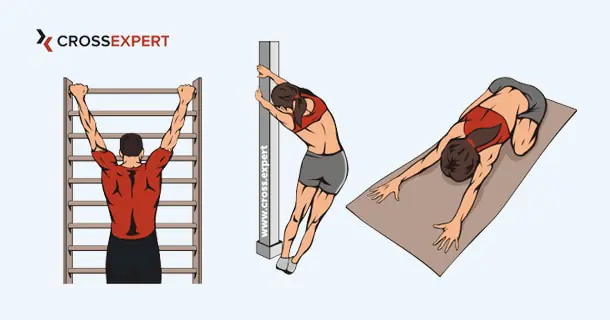
Types of stretching
Having finished with the questions about whether stretching is necessary, it’s worth going through what actually needs to be done? All exercises are divided into three main categories:
- Warm-up stretching involves various turns of the body, slight bends, all in order to warm up the muscles before the approach.
- Dynamic stretching - we take an unattainable range of motion and stretch at an average pace.
- Static stretching - needed to improve overall flexibility.
Let's look at the categories.
Warm-up stretching
First of all, such gymnastics includes exercises with body inclination.
Mill
The mill is a legendary exercise for stretching the back. Be sure to include it in your complexes from time to time.
Bends to the sides several times
Side bends are an excellent exercise that we are familiar with from physical education lessons.
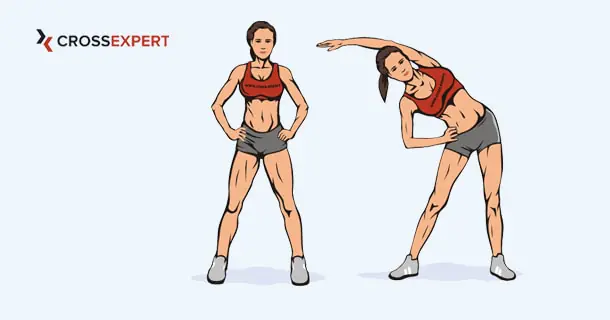
Pelvic rotation
Pelvic rotation is also a classic warm-up exercise.
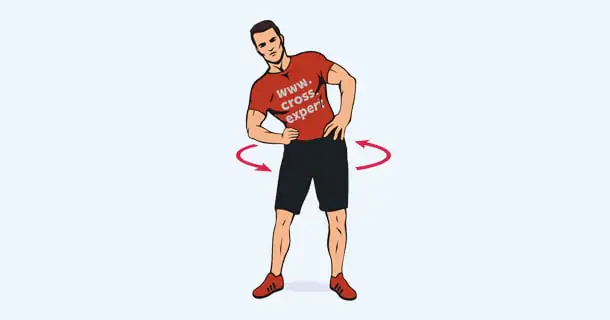
Dynamic stretching
Dynamic stretching partially overlaps with warm-up stretching, but the difference lies in the details of execution and a slightly different technique for similar movements:
Bends towards the legs with the toes touching the feet
Bending over is a great exercise for stretching your back. However, do it with caution and without sudden movements.
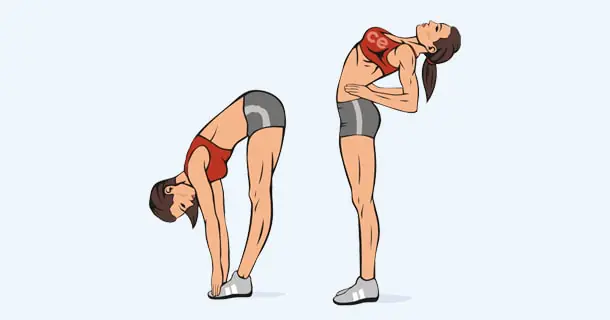
Bends with hands touching heels through the back
Gently stretch back without sudden movements or jerks. A very useful exercise for back muscles and flexibility.
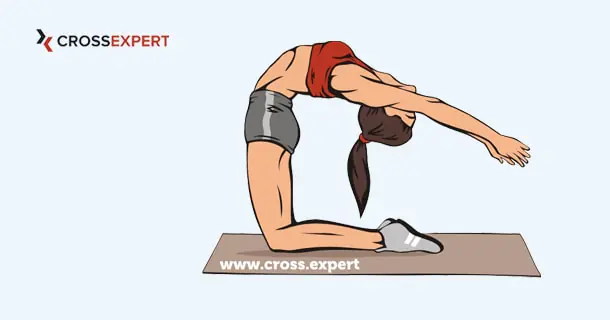
Alternate tilts
Alternate bending to the left and right legs with a wide stance is another classic exercise from physical education lessons.
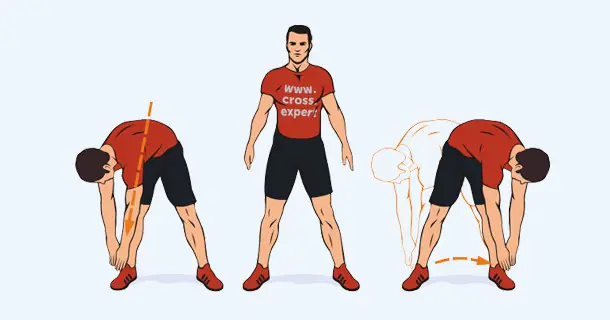
Hyperextension without weight
Hyperextension is a great exercise for stretching your back. However, try to do it carefully and without fanaticism. The effects of this exercise are usually felt only after you finish.
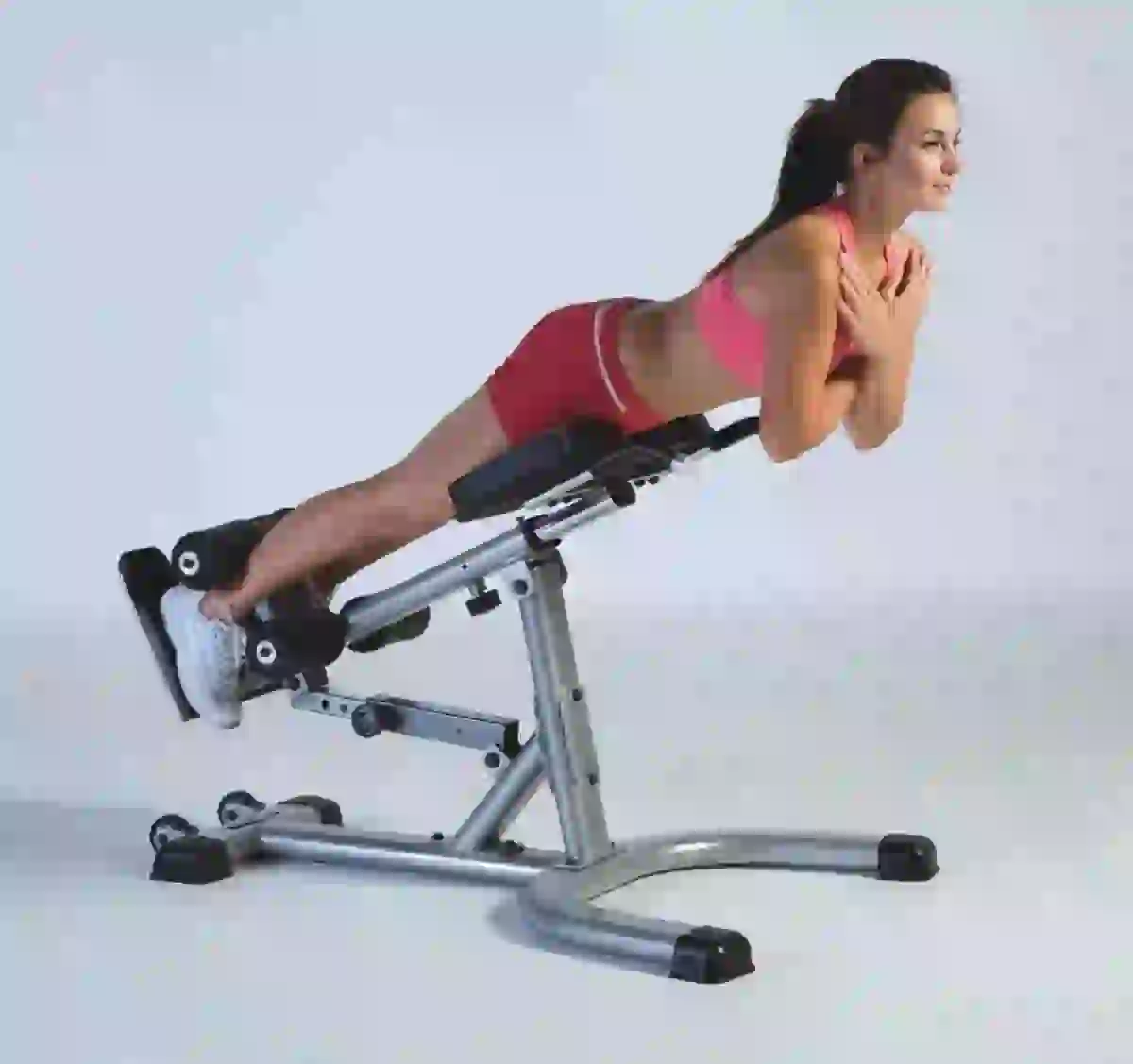
Static stretching
What static stretching is is known to many who at one time wanted to do the splits. In the case of the back, the situation is approximately the same, only with the specifics of the exercise. Here are some exercises that can be performed for static stretching:
The urge to touch your hands to your toes
Without jerking, maintaining a static position.



